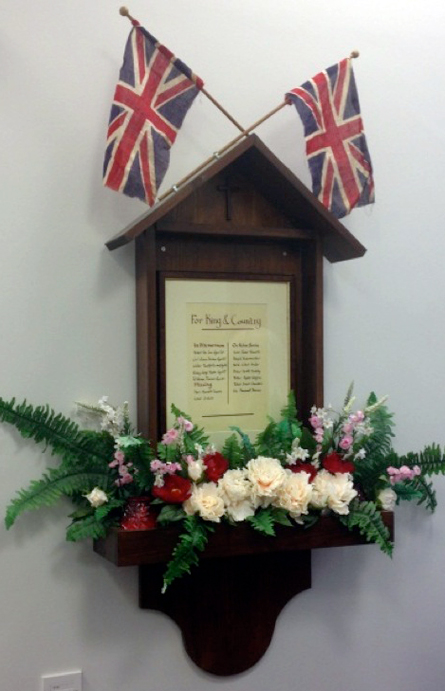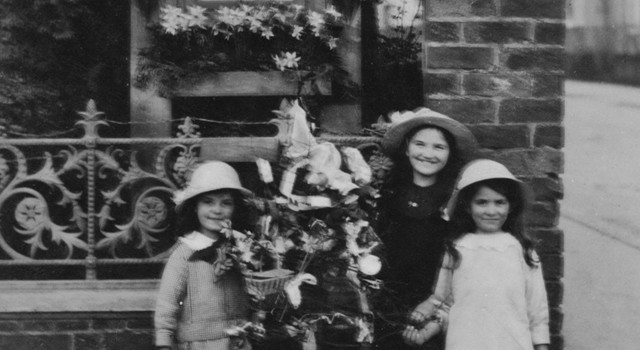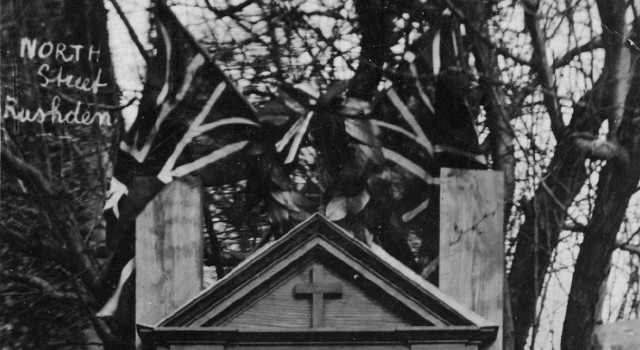Articles
One Comment
By Voices
On 07, Oct 2015 | One Comment | In Commemoration | By Voices
Memento to Memorial: Leicester’s War Memorial Journey
Dr Emma Login, University of Birmingham
When we think of First World War memorials, we may imagine great stone monuments such as the Cenotaph in London or Thiepval on the Somme, France. Yet, these structures frequently took many years to build, and for those with loved ones fighting overseas, and especially for the bereaved, a more immediate and localised response was necessary. As a result, communities constructed countless war memorial shrines in towns and villages throughout the United Kingdom.
![Street Shrine [image courtesy of Rushden Heritage]](http://www.voicesofwarandpeace.org/wp-content/uploads/2015/10/rushdenheritage-northst-2.jpg) Street Shrines
Street Shrines
Often placed in secular everyday settings these local shrines became an important part of many people’s wartime experience. Each small shrine listed the names of those serving, and eventually those killed, from each street or small number of streets. Residents would carefully tend each shrine, leaving flowers and lighting candles. The street shrines provided a very personal link between the communities and soldiers serving at the front. Individuals would recognise the names of local residents, and the shrines provided a focal point where communities could come together to pray for the missing, mourn the dead and offer mutual support to those left behind.
Although many shrines were makeshift, commercial examples were also available. During the War Selfridges even held an exhibition of War Shrines on its 4th floor, and the ‘Great War Shrine’ erected in Hyde Park in 1918 reportedly received over 200,000 floral tributes in the first week of its existence. Yet, despite their popularity, few photographs exist and surviving examples are incredibly rare. This example is from the village of Rushden in Northamptonshire, Leicester also had many war shrines positioned throughout the city.
Temporary Memorial
As the First World War raged on and the death toll continued to rise, many felt that the city needed a larger, less perishable tribute. In Leicester, as early as 1916, officials devised a large temporary memorial to remember those Leicester men that had already given their lives in the Great War. Unveiled on 28th June in the centre of the City the temporary memorial listed the names of the 2129 men already lost to the war. Yet, like the Armed Forces Memorial, in Staffordshire, it left room for the addition of many more names. Although this could not replace the intimacy of the small street shrines, it did provide a space where the city could come together and remember its war dead. The temporary memorial still listed the names, although now not all would be recognisable to the viewer. Instead of giving support on a local level, it provided a space where bereaved individuals could view their loss within the greater loss of the city, and take some comfort for not being alone in their suffering.
![Street Shrine [image courtesy of Rushden Heritage]](http://www.voicesofwarandpeace.org/wp-content/uploads/2015/10/rushdenheritage-northst-1p.jpg) Monumental Memory
Monumental Memory
Despite high levels of memorialisation taking place during the war, it was not until seven years after the end of the war that Leicester’s permanent memorial was unveiled. The memorial took the form of a huge monumental Arch of Remembrance, which was designed by Sir Edwin Lutyens, the architect responsible for the Cenotaph and Thiepval memorial. Unveiled on 4th July 1925, this memorial was different from the temporary memorials that had come before. It held no names and subsumed those killed into the symbolic ‘glorious dead.’ Unlike the temporary shrines, the memorial offered no personal connection between the dead and the bereaved. Instead, it offered comfort in another way, consoling the bereaved by giving patriotic purpose to the deaths of their loved ones, and showing that the city would never forget their sacrifice
Today no street shrines remain in Leicester. The temporary memorial was destroyed in 1954, as a result of its increasingly deteriorating condition. However, the Arch of Remembrance lives on as the focus of Leicester’s War commemoration. Subsequent conflicts have given the memorial new meanings, which now stands as a monument to all Leicester men and women that have lost their lives as a result of conflicts across the globe.
Street shrine photos from war memorials research by www.rushdenheritage.co.uk
 Dr Emma Login has recently completed her PhD at the Ironbridge International Institute for Cultural Heritage at the University of Birmingham. Her research looks at war memorials and their long term development over time, examining war memorials to common soldiers and civilians ranging from 1860 through to the present day.
Dr Emma Login has recently completed her PhD at the Ironbridge International Institute for Cultural Heritage at the University of Birmingham. Her research looks at war memorials and their long term development over time, examining war memorials to common soldiers and civilians ranging from 1860 through to the present day.
This research, charting the development of memorialisation following the First World War in Leicester, was created as part of the AHRC ‘Research in Translation’ Project. This project challenged early career researchers to create an engaging exhibition using material from their research. The display contains images charting the development of memorials from street shrines through temporary structures to monumental memorials, and includes a replica street shrine demostrating the striking visual qualities that these shrines once held. The resulting ‘Memento to Memorial’ display can be seen at the School of Museum Studies, 19 University Rd, Leicester LE1 7RF, UK, until February 2016.
-
Could you please tell me where I may find a list of the soldiers names on Leicester’s Remeberance Arch?
I believe my Great Grandfather James Down maybe in there and I would like to find out!
Regards
Karen Betts
Submit a Comment





Comments